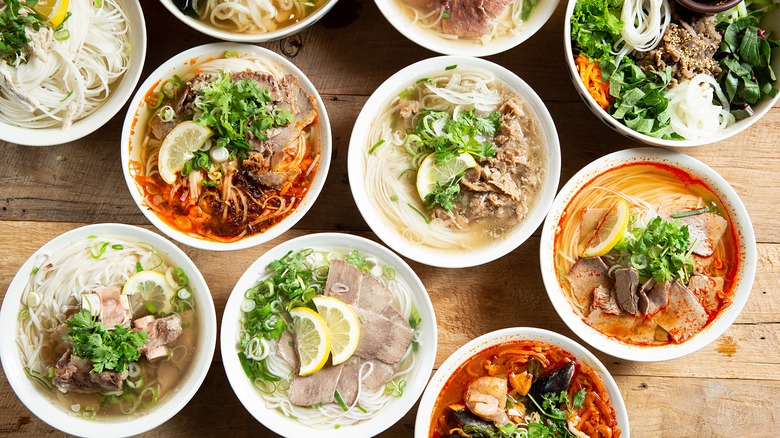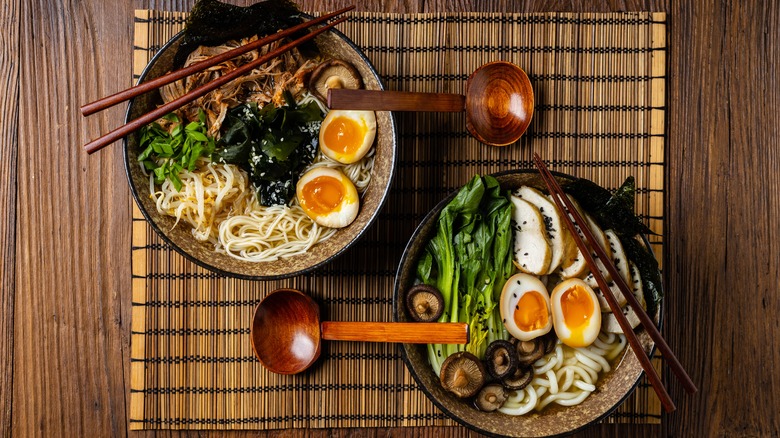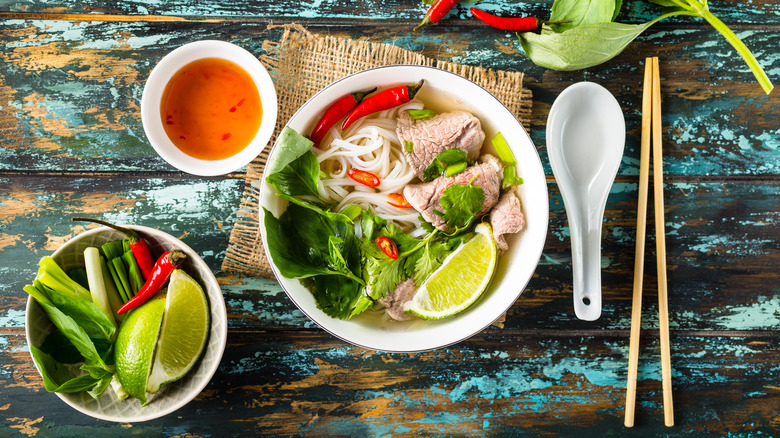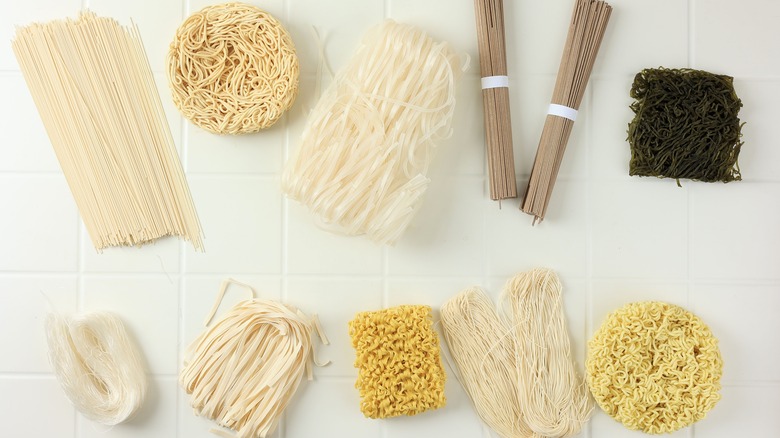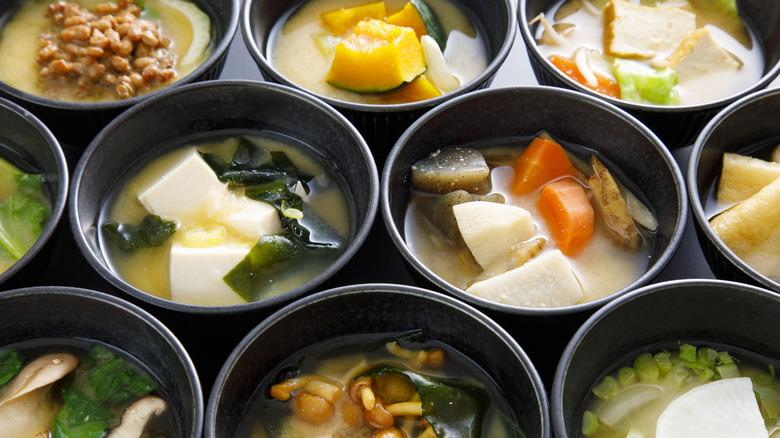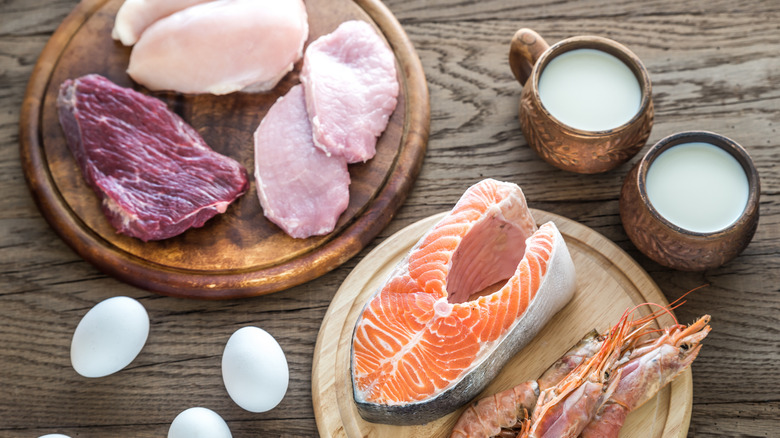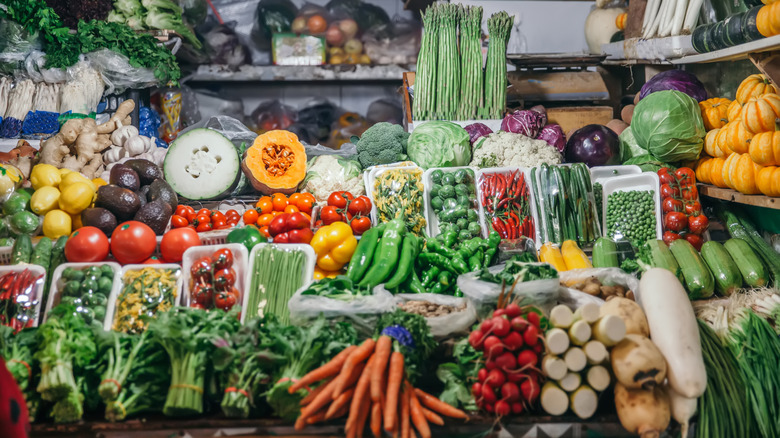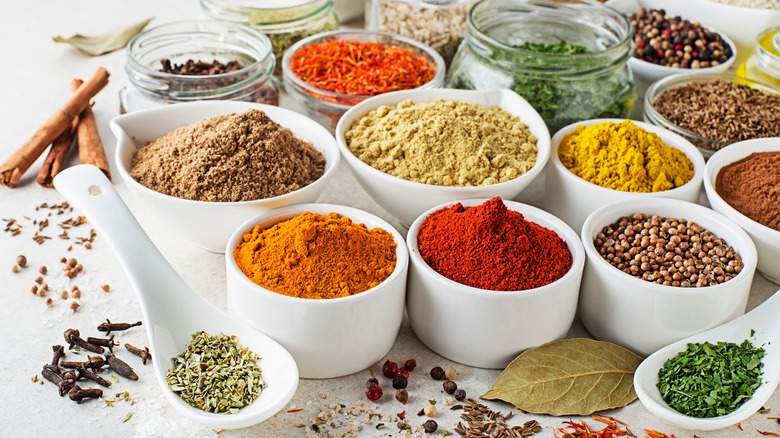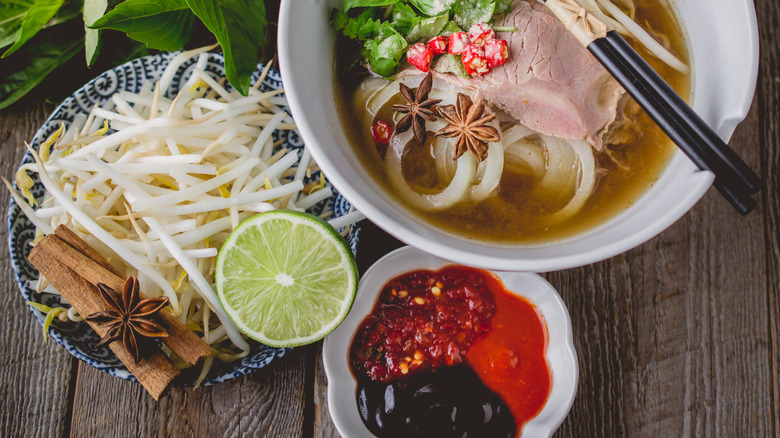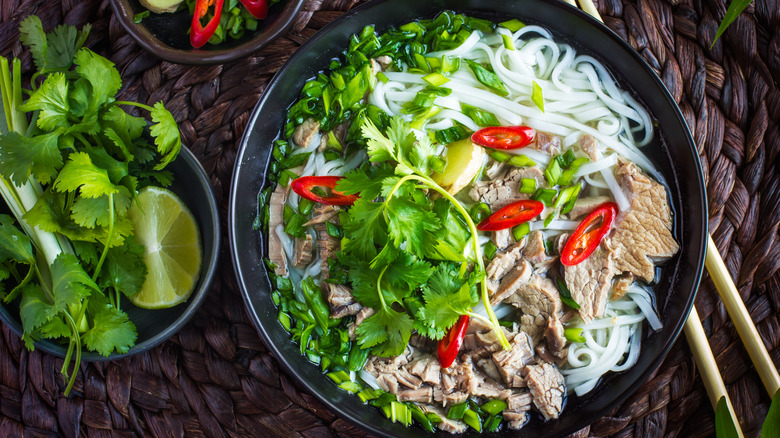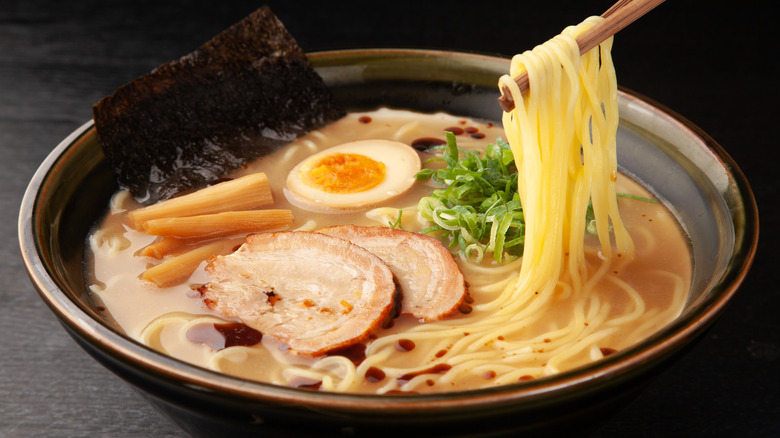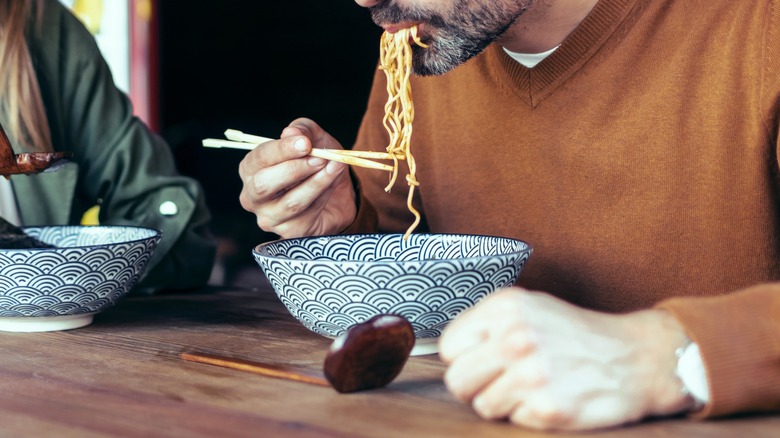Ramen Vs. Pho: Everything You Need To Know
You've probably enjoyed a steamy bowl of pho or ramen before, and if not, you're really missing out. Either way, these prized soups are packed with tender noodles, veggies, meats, and rich, drool-worthy flavors that people worldwide know and love. If you're not super familiar with ramen and pho (or even if you are), they may appear quite similar. While these soups do have a few things in common, like the fact that they're both Asian in origin and contain noodles, they also have plenty of differences that make them unique. Whether you want a little help deciding where to eat, want to make ramen and pho at home, or just want to understand these delicious noodle soups better, there's plenty to discover about each of these dishes.
To compile this comprehensive guide on ramen and pho, I researched their origins, top recipes, expert insights, and more. I also have extensive experience making and enjoying them both in restaurants and at home. If you want to learn everything you need to know about ramen and pho so you can start making them — or simply enjoying them to their fullest potential — this is your guide.
What is ramen?
Ramen is a hearty noodle soup popular around the world. From instant noodle cups and packets to gourmet renditions found in reputable restaurants, this dish has seamlessly woven itself into the global culinary scene. It wasn't always this way, though. Ramen originated in China but didn't become what it is today until it arrived in Japan in the 1880s. In fact, most people think of ramen as being Japanese because of its prevalence in the country's culinary tradition. Even so, ramen has since spread around the globe.
Ramen typically contains sliced meats, vegetables, toppings like nori and egg, and noodles, all in a rich broth. The kind of broth varies, but even in the dish's simplest form — just noodles in clear broth — its smooth texture and flavor ensure that it's delicious every time. You may be most familiar with instant ramen options, but take note: Traditional ramen is much more substantial when you take the time to make it right. You can even turn instant ramen into a restaurant-worthy bowl just by adding a few tasty ingredients.
What is pho?
Like ramen, pho is a hearty noodle soup with roots in the Asian continent. Pho, however, is distinctly Vietnamese — it's even the country's national dish. Pho, pronounced "fuh," is generally thought to have originated near Hanoi in the 20th century. Some people say the dish was inspired by Chinese food, while others believe it was created as a new take on pot-au-feu, a French stew with similar traits. Either way, pho is its own unique dish and is wildly popular both in Vietnam and abroad. Pho isn't as well-known as ramen, at least in the U.S., likely because grocery stores don't stock a collection of instant pho options. But that doesn't mean that it's any less delicious.
Traditionally, pho consists of a slow-simmered beef bone broth, rice noodles, sliced beef, and various toppings. Today, you can also enjoy vegetables, tofu, chicken, and other proteins and broths with your pho. One of the best parts about this dish is that it features a build-your-own component that allows you to flavor and garnish your bowl to best suit your preferences. In addition to your bowl of broth, noodles, and protein, you get a collection of ingredients like lime, Thai basil, bean sprouts, scallions, hoisin sauce, and jalapeños on the side.
Pho and ramen noodles
One of the most discernible differences between ramen and pho is the noodles. Ramen contains wheat noodles, whereas pho is made with rice noodles. The latter are thin, flat, and almost translucent. They're created with glutinous rice flour and almost always sold dried. When cooked, they're deliciously soft but still substantial enough to remain intact and create a pleasing mouthfeel after marinating in hot broth.
While some ramen is made with egg noodles, wheat noodles are considered the standard. And not all ramen noodles are shaped like the wavy, instant variety. Some are straight and are traditionally used in rich, tonkotsu-style broths. Generally, the wavy ones familiar to Americans are paired with miso broths. Both types of ramen noodles are common in lighter ramen broths like shio and shoyu. No matter the shape, ramen noodles are made with salt, water, wheat flour, and kansui. This final ingredient is alkaline water, and it's responsible for giving ramen noodles their signature color and springy, chewy texture.
Comparatively, ramen noodles are significantly more substantial and are chewier, springier, and thicker than pho noodles. Pho's rice noodles are softer than ramen's; they're typically also more thoroughly cooked, unlike the nearly al dente texture of ramen noodles.
Ramen and pho broths
Pho broth is consistently lighter than that in ramen. While some ramen broths are considered light, they can range from mild to heavy. Both dishes also come in broth-less versions, but these aren't nearly as popular.
Pho broth is easily recognized by its clarity. It has a potent aroma, a subtle color, and a well-seasoned flavor that make it perfect for pairing with a variety of ingredients. There are three main types of pho broth, the most traditional of which is pho bo. This beef-based broth is made with simmered beef bones, charred ginger and onions, coriander, star anise, sugar, and other spices. Fish sauce is another common ingredient used to boost umami flavor. Other broths include pho ga, made with chicken, and pho chay, which is vegetarian.
Unlike pho, ramen broths offer a wide range of choices. From dark to creamy to salty to subtle, there's a ramen broth to match your preference. The four main types are shoyu, shio, miso, and tonkotsu. Each type is left to simmer for lengthy periods, allowing all its flavors to blend and develop a rich depth. Shoyu broths are made with soy sauce, giving them plenty of umami goodness; shio broths are made with salt, and their flavor reflects it; miso broths, made from fermented soybean paste, have a bold flavor; lastly, tonkotsu broths are made with pork and often feature a creamy element.
Pho and ramen meats
Both pho and ramen recipes feature a broad range of meats, although pho is traditionally made with beef. That doesn't mean you can't easily find other delicious options — beef is simply the standard. As such, you can often choose between various types of beef, including meatballs, well-done trimmed and untrimmed flank strips, fatty brisket, beef tripe, and thin slices of rare ribeye or tenderloin. Delectable chicken and seafood phos also exist, but fans are often drawn to authentic beef recipes.
Ramen, on the other hand, features a diverse collection of meats, including chicken, seafood, beef, and pork, though the latter is generally the most popular. As such, you'll find this dish made with various kinds of simmered pork belly, shredded pork, and bacon. Grilled steak ramen is also extremely favored. When it comes to seafood, anything from crab to mussels to shrimp to scallops is acceptable. You'll also find a small fish cake on most ramen, regardless of the main protein. While not technically meat, boiled and halved eggs are also added to the top of nearly every type of ramen.
Ramen and pho vegetables
Pho isn't known for containing very many vegetables in the actual soup. It does come with plenty of fresh toppings, but you don't have to incorporate them into your bowl unless you want to. As is, pho generally only contains charred white onions and green onions, both of which are simmered in the broth. Pho chay, the vegetarian variety, often features carrots, broccoli, and large pieces of cabbage; however, those veggies sometimes come on the side, especially if you order take-out.
In contrast, ramen contains a host of veggies right alongside the meat, noodles, and broth. You can add practically any veggie you want to your bowl of ramen, but some are more prevalent than others. Common choices include corn, bamboo shoots, various mushrooms, nori (seaweed), white onion, carrot, green onion, cabbage, bean sprouts, kimchi, pickled ginger, and more. In fact, if you're making an instant version at home, the easiest way to elevate it is by adding some veggies. Don't overlook canned ingredients for your ramen, either, as they just might surprise you. The diverse vegetable composition of ramen is one of the reasons it's so well-loved by all kinds of people and easily fits into various dietary preferences.
Pho and ramen spices and flavors
The moment a bowl of ramen arrives in front of you, it already contains a wealth of complex flavors and spices, unlike pho, which takes a bit of work to reach its nuanced taste. Ramen is well-seasoned with a collection of savory warming spices, leading to over-the-top flavors in every bite. There are practically too many different types of ramen to count, so it's hard to pin down a specific set of spices and flavors, but some are more prevalent than others. For example, Togarashi, also known as seven chile spice, is almost always included. Black or white pepper, garlic paste, Japanese curry powder or paste, and sesame oil are also commonly incorporated into various kinds of ramen.
When a steaming bowl of pho arrives at your table, it isn't necessarily going to overwhelm you with spices and flavors. The broth is somewhat simple compared to ramen's, and you get to add toppings as you like. Before you garnish it with your preferred flavors and ingredients, however, the primary taste you'll get is from the broth's green onions, charred onion, and charred ginger. Additional seasonings like cardamom, cinnamon, clove, star anise, and coriander are also present, but they often take a backseat to the other elements.
Ramen and pho condiments and toppings
Condiments and toppings are where pho really sets itself apart from ramen. While both soups can have an abundance of last-minute ingredient additions, pho does it like no other. Instead of being tossed in the bowl by the chef, you get to add as few or as many toppings and condiments as you like. Most pho is served with a side of Thai basil, cilantro, bean sprouts, sliced jalapeños, hot chiles, mint leaves, lime wedges, hoisin, sriracha, and thinly sliced white onion. This may seem like a lot of ingredients, but once you load up your bowl, you can explore a whole world of diverse flavors. If you really want to eat a bowl of pho like you know what you're doing, dip bites of meat and veggies into the sriracha and hoisin sauces as you go.
Ramen is served ready to eat and with all its condiments in place, though these aren't actually cooked with the rest of the bowl. They're added as toppings right before serving. The most common of these include sesame seeds, nori sheets, fish cake, corn, soft-cooked egg halves, butter, pickled ginger, raw enoki mushrooms, spinach, fresh garlic, menma (fermented bamboo shoots), scallions, and cabbage. Condiments are by no means necessary for ramen, but many people like to add an extra dash of soy sauce or chili garlic sauce to spice it up even more.
Pho is often healthier than ramen
If you're looking for the healthiest option between the two, pho is going to win over ramen pretty much every time. The vast range of various recipes and topping combinations in both types of soup makes comparison challenging, but overall, pho is widely regarded as the healthier dish. One of the main reasons for this is that pho is typically made with bone broth, which is rich in nutrients, encourages bone health, reduces inflammation, may help protect joints, and more (via Medical News Today). Pho is also made with gluten-free rice noodles, is often lower in fat, contains fewer carbs, and has more protein per serving. Lastly, pho features a plethora of fresh veggies and herbs.
Depending on what kind you're eating, ramen can also be considered healthy, just not as much as pho. After all, it is a hearty soup with lots of veggies, right? Compared to pho, however, it just doesn't stack up. Typically, ramen contains fattier meats, less protein, and more carbs than pho. Some versions may be lower in sodium, but this isn't always the case.
Where can you buy pho and ramen?
Thanks to the prevalence of instant options, ramen is often much more widely available than pho. You can grab a packet or cup of ramen in almost any supermarket, and it's even readily available in convenience stores. Unfortunately, the same can't be said for pho. You may be able to find rice noodles in some grocery stores, but you'll likely have to make the broth yourself. The exception to this rule is Asian markets and grocery stores. If you're lucky enough to have one nearby, you should be able to find several pho broths, as well as an extensive selection of ramen.
If you don't feel like making ramen or pho yourself but want a gourmet option, Asian restaurants have you covered. As you might have guessed, Japanese restaurants serve ramen, and Vietnamese restaurants serve pho. Occasionally, Asian fusion spots offer ramen and pho on the same menu, but these establishments are few and far between. Either way, thanks to the popularity of both soups, if you're a city-dweller, you can probably find several places to satisfy both your ramen and pho cravings.
Can you substitute ramen noodles for pho noodles and vice versa?
Ramen noodles and pho noodles are nothing alike. Pho noodles are soft and thin, whereas ramen noodles are chewy, springy, and thicker by comparison. Pho noodles are also made from rice flour, while ramen noodles are made with wheat flour and alkaline water. Even with all the differences in texture and ingredient composition, however, you can still substitute one for the other if you prefer. The resulting soup will be noticeably different from its typical form, but thanks to the versatility of flavor and ingredients in each, a change in noodles won't ruin a recipe.
If you or someone you're cooking for is gluten-free, substituting pho noodles in place of ramen noodles is a fantastic option. This switch allows you to experience all the rich flavors of ramen, even if the noodles' mouthfeel is totally different. Just beware when doing the inverse — while the soup will still be tasty, ramen noodles will take pho out of the gluten-free category.
Is ramen or pho better?
There's no definitive answer when determining whether ramen or pho is the better dish. Ultimately, your dish of choice will depend on your palate, preferences, and mood. That being said, the consensus on Reddit is that ramen is preferred over pho. People seem to enjoy ramen's rich broth and ample variety of toppings more than pho's light broth and more limited topping options. Some users think ramen can be a bit too heavy, especially when eaten in the middle of the day, but for the most part, ramen is the winner.
Nonetheless, there are a few factors to consider when deciding for yourself which of these two soups you prefer. If you like chewy noodles and rich broths, ramen could easily be your favorite. If fresh veggies, herbs, and light broths are your thing, pho is the obvious choice. Still, you may change your mind from day to day. Who says you have to pick a permanent favorite, anyway?

